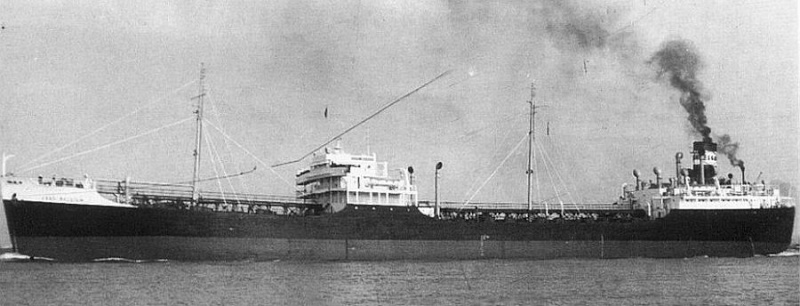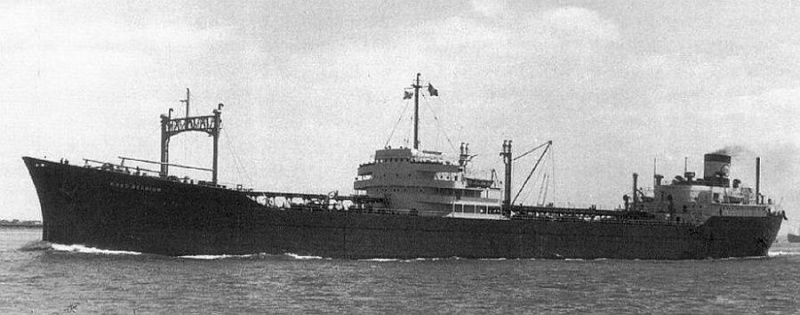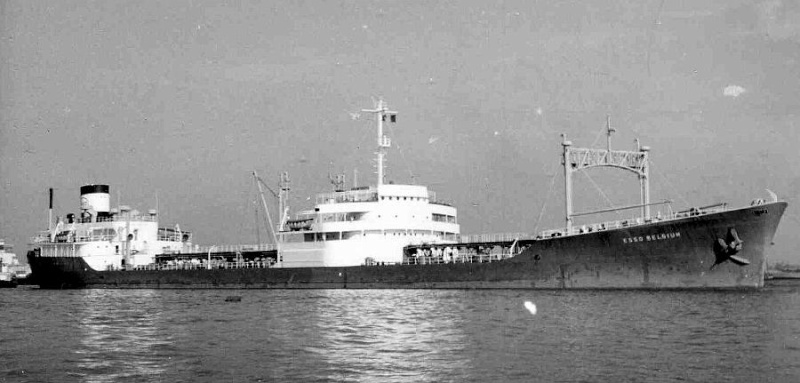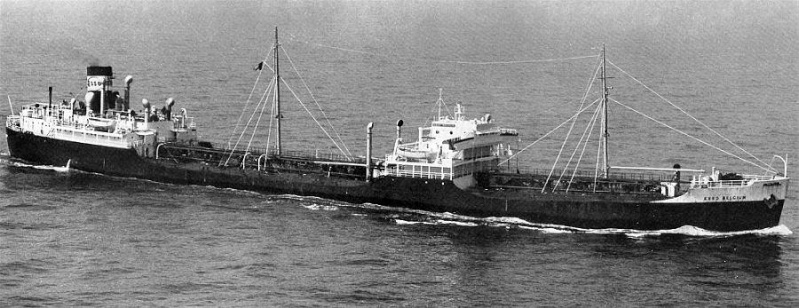MS Esso Belgium

Like many merchant vessels which served the Allied cause in World War II, the tanker Esso Belgium was manned by exiles from many lands which had fallen to the conquerors. The Belgians of her crew, as well as the nationals of other occupied countries who served with them, sailed on many ships and roamed the seven seas, but for five long years-from the chaotic spring of 1940 until V-E Day, May 8, 1945-they could not set foot on their native soil or communicate with their loved ones. Their only word from home was an occasional Red Cross message relaying meager news of the welfare of their families.

Letter of Appreciation
During the war period Captain Ambrose A. Van denkcrckhove was in command of the Esso Belgium and Chief Engineer Charles Wouters was in charge of her engineroom. The following letter paid an enthusiastic tribute to these officers:
January 29, 1945 Mr. B. B. Howard 30 Rockefeller Plaza New York, N. Y. Dear Sir:
It is my desire to express to your Company my regard for the master of the MS Esso Belgium, Captain A. Vandenkerckhove, on whose ship I am serving as the Naval Armed Guard commander.
The captain has given me, as the naval officer on board, the most complete and wholehearted cooperation. Every reason-able request pertaining to military matters or to the comfort of my gun crew was carried out by him with dispatch.
Captain Vandenkerckhove has the respect and admiration of everyone who knows him, by reason of his ability and experien-ce and because of the fierce pride in which he holds his ship. The captain is tireless in his devotion to his duty and your Company can well be proud of him and the splendid record he is making.
I would be remiss if encomiums were not also paid to Mr. Charles Wouters, the chief engineer of this ship, whose energetic, able, and inde fatigable work has made it possible for this ship to establish a record of reliance and dependability. The cap-tain and the chief engineer have been the main factors in having the Esso Belgium earn the high praise of convoy commo-dores and the gratitude of the Navy for her great support and aid in the war effort.
Very sincerely,
Nathaniel S. Ruvell
Lt. (jg) D-V(s) USNR
At that time Mr. Howard was General Manager of Marine Operations. He was subsequently elected a member of the Board of Directors.

The Esso Belgium was at Baytown, Texas, on September 3, 1939, first day of war in Europe, having arrived there from Antwerp on September 2. She was then owned by the Standard American Petroleum Company of Belgium, a Standard Oil Company (N. J.) affiliate. At Baytown the tanker loaded 113,-838 barrels of gasoline, water white, tractor fuel, gas oil, and other refined oils for Rotterdam. This voyage was followed by a trip from Aruba to Antwerp and two from Aruba tp Rotterdam and Antwerp, all with similar cargoes.
Grounded
On April 2, 1940 the Esso Belgium had the misfortune to go aground in the North Sea while en route to Rotterdam on the last of the voyages referred to above. Of interest in itself, the story well illustrates some of* the difficulties which beset merchant ships in wartime.
At the start it should be stressed that, as reported by investigating officials, "The inquiry revealed that the master was not to be blamed, that he followed strictly the instructions given by the British and French Admiralties, and that he took all precaut-ionary nautical measures practicable, under the circumstances, to avoid an accident."
On the voyage in question, the Esso Belgium sailed from Aruba on March 2, 1940. On March 18 she arrived at Weymouth, England, where her log books were examined by the British Contraband Control. Weighing anchor, she proceeded to the Downs, an anchorage near Dover, where she arrived March 19. Here there was considerable delay, during which the vessel took on fresh water and her papers were again examined by the Contraband Control. Finally she was given permission to leave the Downs and ordered to proceed to her destination, Rotterdam, via Dunkirk and Zuydcoote Pass - that is, through the dangerous shoal waters along the north coast of France and Belgium, east of Dover Strait.
The Esso Belgium reached Dunkirk on March 29 and anchored in the Roads. From this point the story is told in the statement of the Esso Belgium's master. All of the roads, banks, etc., referred to are in the North Sea, near the border between France and Belgium.

North Sea Complications
To quote Captain Vandenkerckhove's report:
"On March 31, 1940 the French Admiralty at Dunkirk instructed me to sail as soon as possible and proceed from Dunkirk to Rotterdam by way of Dunkirk Eastern Roads, Zuydcoote Pass, Nieuport Roads, and territorial waters, passing south of Nieuport and Wenduyne Banks, to pick up a pilot near Wandelaar Light Vessel. I was instructed to keep within territorial wa-ters, following the Wielingen Channels to Flushing Roads, and thence by the Oostgat Channel.
"Upon receiving my sailing orders on March 31 I signaled that I required a pilot. In reply I was told that there was no pilot available; then that a pilot would be sent out on the afternoon of April 1; and finally, again, that there was no pilot to be had. The captain of a French Admiralty patrol boat told me that I would have to follow him through Zuydcoote Pass. At 5:29 p.m. he flatly ordered me to sail.
"The Esso Belgium got under way at 5:54 p.m. on April 1, 1940 and, under guidance of the patrol boat, passed out through the Zuydcoote Pass and continued northeasterly through the West Deep and south of Nieuport Bank. While passing through the Zuydcoote Pass in the neighborhood of a buoy which I observed to be marked '4E', I felt a slight vibration of the .vessel and presumed that we had touched bottom. The vibrations lasted only about four seconds, however, and the vessel main-tained her course. The tide was then high and, while the soundings shown on the chart were about four fathoms, the rise of the tide should have provided ample water for my vessel to pass.
"At 6:45 p.m. I stopped the engines and reported the grounding to the captain of the patrol boat. He replied it was impossible for us to touch ground, as there was a depth of at least 20 meters of water at that point. According to the chart, however, there was no such depth.
"Two minutes later, at 6:47 p.m., the patrol boat left us and the Esso Belgium continued alone, northwest through Nieuport Roads. At 7:19 p.m. we anchored in the vicinity of Nieuport Bank Buoy at the southwestern end of Nieuport Bank.
"We got under way at 8:23 a.m. April 2, setting a course of 59 degrees true. Our automatic sounding device was put in ope-ration and showed soundings of 9 to 10 fathoms. I estimated that we would be through the northeast channel shortly after 9 a.m. and thus have ample water on the tide.
"At 8:50 a.m., at 9:08, and at 9:19, further bearings were taken. At 9:19, in order to pass through the northeast channel, the engines were put slow ahead and the course was changed from 59 degrees true to 42 degrees.
"The automatic sounding device continued in operation and gave no warning of a decrease in water. We proceeded slowly, with no change in engine movements, and all went well until 9:21 a.m. I was about to order another bearing taken in order to fix the position of the vessel for a change of course to a northerly direction to pass through the northeast channel, when the Esso Belgium came to a stop, aground.
"There was no shock, the ship apparently having taken ground gently on the small shoal shown on the chart on the right hand side of the channel. Even here, according to the soundings on the chart, there should have been ample water, in view of the high tide, but apparently the chart was not accurate. The position of the grounding was Latitude 51°13' North, Longitu-de 2°46' East (or about 5 miles off shore, opposite a point half way between Nieuport and Ostende, Belgium).
"Both engines were reversed with rudder amidships, but the ship failed to back off. Soundings taken around the ship showed only 24 feet of water just forward of the bridge. The bow and stern were in deep water.
"At 9:50 a.m. I sent my position to the pilot station at Ostende and asked for tugs."
Afloat-Then Aground Again
The next two days were spent in efforts to free the Esso Belgium. Three tugs, the Zeeleeuw, Zeehond, and No. 5 - the latter two belonging to the Belgian Government - came out to assist the grounded tanker.
"With them," said Captain Vandenkerckhove, "they brought two pilots. Both these men told me they would not attempt to take the Esso Belgium out through the northeast channel, the route that I had been instructed to follow."
Twice, at high tide, the three tugs attempted to pull the ship off, and twice they failed. The third attempt, made on the morning of April 3, was successful, but the hawser of the Zeeleeuw parted and the vessel again took ground. A fourth try was likewise unsuccessful.
On the afternoon of April 3, the tugs Zwarte Zee and Roode Zee took over the job on a "no cure, no pay" salvage contract.
"The Esso Belgium was now grounded," said Captain Vandenkerckhove, "on the starboard side just forward of the bridge, and appeared to be pivoting, as her heading changed frequently during the efforts to tow her off."

No Serious Damage
The first two efforts of the Zwarte Zee and the Roode Zee failed. For the third attempt, the salvage company's tug Thames took the place of the Roode Zee. This attempt was successful and at 10:21 p.m. on April 4 the Esso Belgium came afloat. She anchored until April 6 and then, attended by the Zwarte Zee, proceeded to Rotterdam without further incident. Further efforts to get a pilot having failed. Captain Vandenkerckhove had the responsibility of conning the ship.
Following discharge of the Esso Belgium's cargo at Rotterdam and Antwerp, the vessel was placed in dry dock, where it was found that she had sustained no serious damage as a result of her misadventure.
The Esso Belgium returned to Aruba on May 9, 1940. She had been scheduled to load for the Brazilian ports of Santos, Rio de Janeiro, and Belem, but on May 10, the day after her arrival, the German army invaded Belgium, Luxemburg, and the Netherlands to begin the momentous campaign that ended with the fall of France.
The Esso Belgium's orders were changed, and on May 12 she sailed from Aruba for New York. While she was en route, the Netherlands army was ordered to lay down its arms on May 14, and three days after the tanker's arrival at New York on May 18, the Belgian Government requisitioned all Belgian vessels, May 21, 1940. On May 28, the King of the Belgians surrend-ered his troops.
Ship Without A Country
The Esso Belgium had become, in effect, a ship without a country. Until the international situation was clarified, she could not be operated. There was no urgent need for her services, however-at that time many tankers were in tie - up - and for months she lay at anchor in New York harbor.
Arrangements were finally made for the vessel's return to service under ownership of the Belgian Overseas Transports, S.A., and time charter to the Panama Transport Company. She sailed from New York on February 15, 1941 for Aruba.
For more than three years the tanker served in western Atlantic and Caribbean waters. Her cargoes of crude and fuel oils were carried from Aruba and the busy supply ports of Venezuela and Colombia to Canada, the United States, the Panama Canal Zone, and South America.
The Esso Belgium was transferred to the Pacific coast in October, 1944, when she transported to Vancouver a cargo of Colombian crude oil loaded at Cartagena. Two trips from California to Pearl Harbor followed, after which she returned to the Atlantic and a few months of coastwise service.
June, 1945 saw the tanker back on the west coast. Loading at Covenas, Colombia, and at San Pedro, she discharged at Vancouver and San Diego. On August 27 she left San Francisco with 96,172 barrels of fuel oil, and V-J Day, September 2, 1945, found her en route to Eniwetok.

The wartime transportation record of the Esso Belgium was in summary as follows:
| Year | Voyages (Cargoes) | Barrels |
| 1939 | 2 | 234,931 |
| 1940 | 3 | 344,809 |
| 1941 | 19 | 1,913,637 |
| 1942 | 14 | 1.409,756 |
| 1943 | 6 | 627,526 |
| 1944 | 11 | 1,103,777 |
| 1945 | 12 | 1,238,886 |
| Total | 67 | 6,873,322 |
The MS Esso Belgium was built in 1937 by Aktie. Burmeister & Wain's M.S., at Copenhagen, Denmark.
A twin-screw vessel of 15,250 deadweight tons capacity on international summer draft of 29 feet, 10 1/4 inches, she has an overall length of 507 feet, 6 inches, a length between perpendiculars of 485 feet, a moulded breadth of 74 feet, 6 inches, and a depth moulded of 37 feet. With a cargo carrying capacity of 131,367 barrels, she has an assigned pumping rate of 4,000 barrels an hour.
Her Diesel engines develop 4,000 shaft horsepower and give her a classification certified speed of 11.5 knots.
